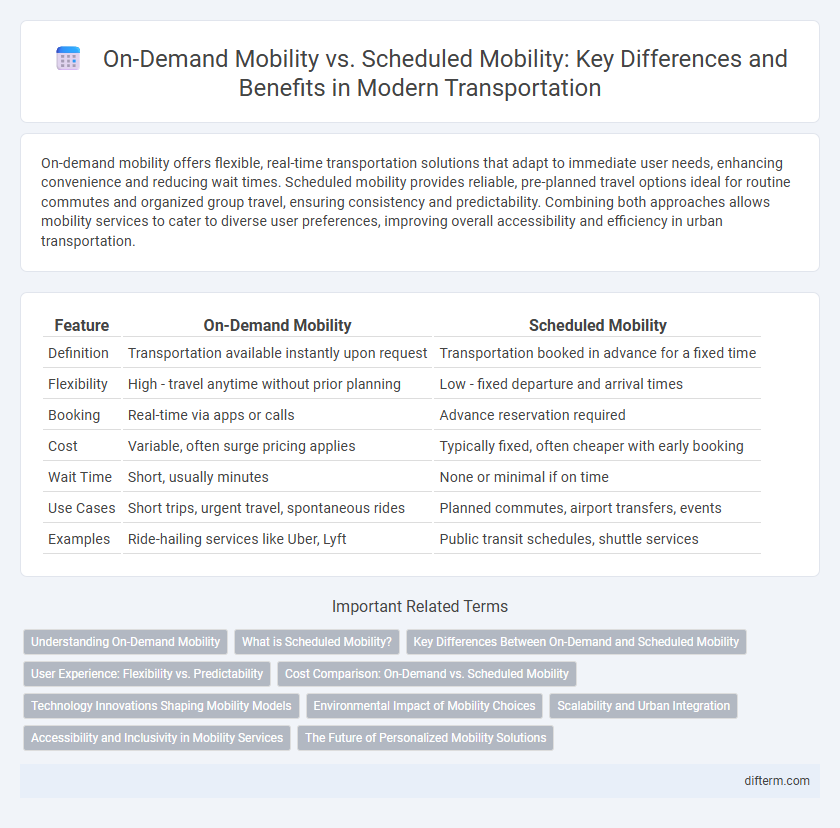On-demand mobility offers flexible, real-time transportation solutions that adapt to immediate user needs, enhancing convenience and reducing wait times. Scheduled mobility provides reliable, pre-planned travel options ideal for routine commutes and organized group travel, ensuring consistency and predictability. Combining both approaches allows mobility services to cater to diverse user preferences, improving overall accessibility and efficiency in urban transportation.
Table of Comparison
| Feature | On-Demand Mobility | Scheduled Mobility |
|---|---|---|
| Definition | Transportation available instantly upon request | Transportation booked in advance for a fixed time |
| Flexibility | High - travel anytime without prior planning | Low - fixed departure and arrival times |
| Booking | Real-time via apps or calls | Advance reservation required |
| Cost | Variable, often surge pricing applies | Typically fixed, often cheaper with early booking |
| Wait Time | Short, usually minutes | None or minimal if on time |
| Use Cases | Short trips, urgent travel, spontaneous rides | Planned commutes, airport transfers, events |
| Examples | Ride-hailing services like Uber, Lyft | Public transit schedules, shuttle services |
Understanding On-Demand Mobility
On-demand mobility provides flexible, real-time transportation options through digital platforms, allowing users to request rides instantly without adhering to fixed schedules. This model leverages dynamic routing and vehicle availability to optimize efficiency and user convenience, contrasting with scheduled mobility's predetermined routes and timetables. Understanding on-demand mobility highlights its role in reducing wait times, enhancing accessibility, and adapting to fluctuating passenger demand in urban environments.
What is Scheduled Mobility?
Scheduled mobility refers to transportation services that operate on fixed routes and timetables, providing predictable and consistent travel options for passengers. This mode of mobility often includes buses, trains, and shuttles with established stops and departure times, ensuring reliability for commuters. Scheduled mobility optimizes resource allocation and helps manage passenger flow during peak hours, enhancing overall system efficiency.
Key Differences Between On-Demand and Scheduled Mobility
On-demand mobility offers flexible, real-time transportation services that adapt to user requests instantly, contrasting with scheduled mobility that operates on fixed routes and predetermined timetables. Key differences include responsiveness, cost structure, and user convenience, where on-demand systems leverage GPS and smartphone apps to optimize routes dynamically. Scheduled mobility provides predictability and efficiency for high-capacity transit but lacks the personalized accessibility inherent in on-demand solutions.
User Experience: Flexibility vs. Predictability
On-demand mobility offers unparalleled flexibility by allowing users to customize routes and departure times, enhancing convenience in real-time travel decisions. Scheduled mobility provides predictability through fixed timetables, enabling users to plan journeys with certainty and reduce wait times. Balancing these approaches optimizes user experience by catering to both spontaneous travel needs and structured commuting patterns.
Cost Comparison: On-Demand vs. Scheduled Mobility
On-demand mobility often incurs higher per-trip costs due to dynamic pricing models and real-time vehicle dispatch, increasing operational expenses for both providers and users. Scheduled mobility benefits from route optimization and fixed schedules, lowering costs through economies of scale and better resource allocation. Comparing cost efficiency, scheduled services generally provide more predictable and affordable pricing, making them a cost-effective choice for regular commuters.
Technology Innovations Shaping Mobility Models
On-demand mobility leverages real-time data analytics, AI algorithms, and IoT connectivity to provide flexible, user-centric transportation options that respond instantly to demand fluctuations. Scheduled mobility relies on advanced predictive modeling and machine learning to optimize fixed-route and fixed-time transit services, enhancing efficiency and resource allocation. Emerging technologies such as 5G networks, autonomous vehicles, and blockchain-based payment systems are driving the convergence of on-demand and scheduled mobility models, fostering seamless multimodal integration and improved urban mobility experiences.
Environmental Impact of Mobility Choices
On-demand mobility reduces environmental impact by optimizing vehicle usage and minimizing empty trips, leading to lower emissions compared to scheduled mobility that often results in fixed routes with underutilized capacity. Electric and shared on-demand services further decrease carbon footprints by maximizing energy efficiency and reducing reliance on private fossil-fuel vehicles. Choosing on-demand mobility solutions aligns with sustainable transportation goals by cutting greenhouse gas emissions and supporting urban air quality improvements.
Scalability and Urban Integration
On-demand mobility offers superior scalability by dynamically adjusting to fluctuating passenger demand, reducing idle vehicle time and optimizing route efficiency compared to fixed-schedule systems. Its flexible nature enables seamless urban integration, accommodating diverse travel patterns and supporting multimodal connectivity in complex city environments. Scheduled mobility, while predictable, often struggles to adapt to peak demand variations, limiting its responsiveness and overall capacity in dense urban landscapes.
Accessibility and Inclusivity in Mobility Services
On-demand mobility services enhance accessibility by allowing users to request transportation exactly when and where they need it, eliminating barriers posed by fixed schedules and routes. Scheduled mobility, while reliable, often limits flexibility and may exclude individuals with irregular or urgent travel needs, impacting inclusivity. Integrating on-demand solutions with traditional transit expands comprehensive coverage, ensuring equitable mobility access for diverse populations, including those with disabilities and individuals in underserved areas.
The Future of Personalized Mobility Solutions
On-demand mobility offers real-time, flexible transportation services tailored to individual schedules, while scheduled mobility relies on fixed timetables and routes. Advances in AI and IoT integration enable personalized mobility solutions that optimize route efficiency, reduce wait times, and adapt dynamically to user preferences. This shift toward adaptable, user-centric transit models promises to enhance urban mobility sustainability and accessibility.
on-demand mobility vs scheduled mobility Infographic

 difterm.com
difterm.com